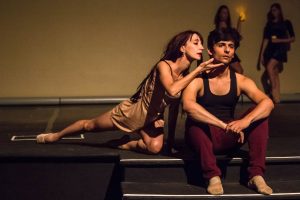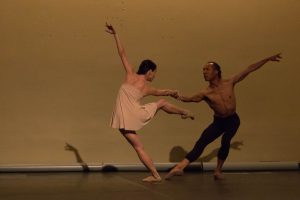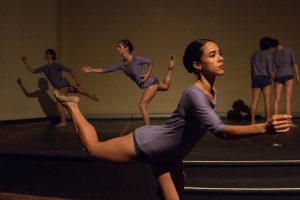Good Beer, Terrific Ballerinas, at “Beer and Ballet”

Ana da Costa and Stephano Candreva in “Spellbound.” Photo: Carol Flangan
A sampling of local craft beers and an intriguing venue—the just-opened Park6 in Bankers Hill—were the clever marketing elements of “Beer and Ballet,” California Ballet’s show of brief contemporary pieces. But the program last weekend offered far more than marketing gimmicks. In particular, “Beer and Ballet” showcased California Ballet’s international roster of stunning ballerinas.
The company’s two female principals, long-legged, elegant Ana da Costa and vivid Reka Gyulai, hail from Brazil and Hungary, respectively. Both were riveting in steamy pas de deux from “Ruled by Secrecy,” by associate artistic director Jared Nelson. And da Costa played an irresistible temptress in Trystan Merrick’s “Spellbound,” whispering in Stephano Candreva’s ear and drawing him into a sultry dance to a slow, moody version of Stevie Nicks’s “Rhiannon.”
Of the Americans, Tess Lane sparkled with joie de vivre in the flirty “Oblivion” by Zachary Guthier, and Amanda Daly did a jazzy, show-stealing turn to a Gypsy swing tune in “Spellbound.” Daly has trained with Alonzo King LINES Ballet, which does very contemporary work, and Jean Isaacs’ San Diego Dance Theater, and it showed in her wonderfully grounded musicality.
The men provided strong partnering—Guthier lay supine and pressed Gyulai into lifts in “Ruled by Secrecy,” and, in “Spellbound,” da Costa did a flying leap into Candreva’s arms—but this felt like the women’s show.
The choreographers included seasoned artists like Nelson and Peggy Dolkas, associate director of Utah’s Ballet West II. In Dolkas’s “Sette Regazze,” women from the junior company were implacable warriors, walking in deep, earthy plies to the iconic “Dance of the Knights” from Prokofiev’s “Romeo and Juliet.” (You’ll know it when you hear it.) And her “Desoriente” gave company apprentice Melanie Ziment a lyrical solo.

Reka Gyulai and Shawn Burgess in “From the Depths of Dreams.” Photo: Carol Flangan
The rest of the ten pieces were premieres created by company dancers. Overall, the newer dance makers did well at a prime directive of choreography, capitalizing on their dancers’ strengths and making them look fantastic—for instance, the radiant Lane in Guthier’s “Oblivion.” And Merrick’s “Spellbound” showcased da Costa, Candreva, Daly, although the three sections of this piece didn’t cohere.
Jenny Asseff, in “Before the Dawn,” nicely echoed the counterpoint in her Vivaldi score. “From the Depths of Dreams” by Jeremy Zapanta featured urgent partnering by two couples. The dancers were stalking animals in Daly’s “Untitled,” though I would have liked to see more influence on the dance from the Bollywood score.

Tess Lane in “Encounters.” Photo: Carol Flangan
Of the dancer-created pieces, the standout was Gyulai’s “Encounters,” with its clean movements and strong through-line. Six women appeared to be struggling, each in her own world—even doing unison moves, they seemed not to see one another. They stood frozen as a man (Zapanta) entered and went from one to the next, gently trying to rouse them. At last, Gyulai responded and joined him in a delicate pas de deux—in a lovely move, he held her while her back leg fluttered. As they danced, the other women did unison poses and a slow-motion run. At the end of “Encounters,” I felt I’d been taken somewhere, related to our fear of connecting but the rewards when it happens.
